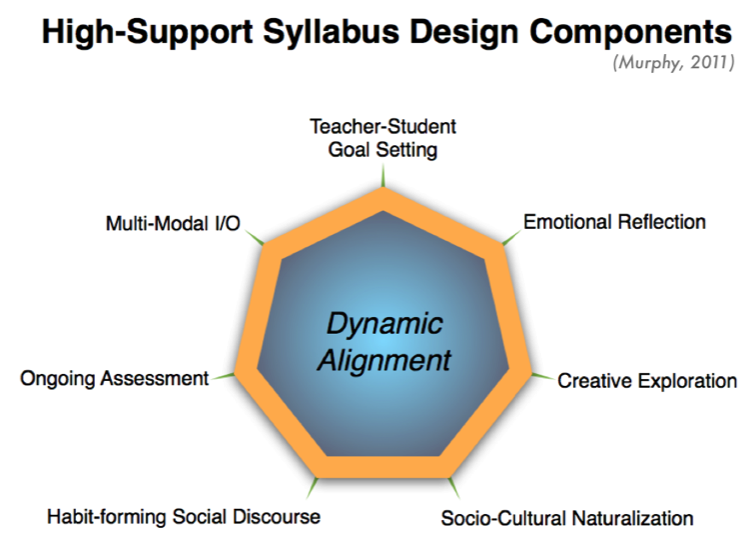High-Support Syllabus Design: Considerations
(a)
Neuroscience offers research but where shall we begin when designing neuro-effecient pedagogy? Perhaps the best place to start is not from scratch. However, rather then simply adjusting PPP and/or Grammar-Translation methods to fit our needs, the teaching for understanding (TfU) framework offers a sound pedagogical framework developed through decades of research both in the classroom and in the lab. This sounds like a reasonable place to begin although the TfU framework is not actually designed for EFL teaching contexts. The initial challenge therefore is to bring TfU and TEFL together for a synthesized approach. This should a reasonable starting point for designing protocols for EFL activities and textbook designs.
First let us review the four points in the TfU framework and see how they can be related to the EFL context, then consider them in conjunction with the 42 Maxims.
Generative topic (GT): A remarkable feature in the TfU framework is the advent of the generative topic, although the concept may be somewhat difficult to grasp at first. The ideas is, to force the teacher at the planning stages to come up with teaching topics that strongly and easily generate more thinking and thus more learning. The lesson plans of a unit of study all revolve around a single generative topic. For it to be a true GT, the topic must generate interest and deep thinking in both the student and the teacher. This creates student-teacher alignment and goes a long way for teacher burnout.
How can this be applied to the EFL classroom? The possibilities are exciting. For one, by introducing a GT concept to EFL teachers, it suddenly breaks them free from the grammar syllabus. Although it may be argued that the study of grammar points could be a form of GT, the study "about" L2 (as in grammar teaching) is really only generative if you are a grammarian and/or happen to be studying linguistics. Moreover, the EFL context, by definition, is a context that is not rich in real world English language usage outside of the classroom. By defining a generative topic that will the the central topic per unit (such a 'health', 'love', 'management', or 'capitalism'), students and teachers alike will have that one specific GT aligned and on their minds during the duration of the study. By having such a keen focus on a single generative topic that naturally blends in with life outside of the classroom, it allows higher chances of 'aha' moments outside of the classroom, linking EFL with real life. This can be a godsend for teachers in difficult EFL contexts because it potentially brings the EFL context a few steps closer to the ESL context -- a much more ideal teaching and learning context for L2.
UG: Understanding Goals The discussion of making learning goals explicit and transparent in the classroom may sound mundane, yet in practice it seems to be quite elusive when the goals reach further than simplistic rote memorization. Perhaps this is a key reason for the popularity of the PPP methodology. The goals are clear from the beginning to end in PPP sessions and they remain transparent even when more formal assessment comes into play. This makes PPP attractive to both the students and the teachers — in this sense, PPP teaching is an interesting phenomenon. Unfortunately, while PPP style rote memorization certainly has cemented its place in second and foreign language learning, PPP learning should never be mistaken for true understanding of language. Why do I say this? Anybody can learn vocalized phrases in a top down, vocal mimicry of any given language on the planet if given enough coaching — while not have a clue as to what they were saying. This is why setting forth strong and transparent UGs is so vital in the language classroom. As long as teachers articulate explicit goals that aim for real understanding (as opposed to superficial learning) and make goals public to students often during class time, meaningful teacher-student alignment can take place. This allows for the language to be much more meaningful for the students. Although this may sound like a simplistic concept (and can therefore easily be overlooked), it should be a cornerstone in EFL pedagogy.
Ongoing Assessment: This concept is not particularly new, but recent research in game theory sheds light on why ongoing assessment is crucial and how it can be implemented efficiently. As a university instructor in Japan, I am often made aware of teachers who assess their students solely on their final exams and attendance. What a shame. Students of these teachers have no opportunities to learning from their mistakes in such contexts. No further interest is generated if assessment only comes at the very end of the course. They literally receive their stamp and move on to the next subject. How disjointed and "un-generative" this structure is. Ongoing assessment takes a stab at such teaching practices. It forces the teacher to provide multiple layers of feedback learning opportunities in the classroom. I say feedback learning opportunities because not only is there teacher to student assessment, but there is also peer-to-peer assessment, and self-assessment. Learning comes not only from receiving assessment, but also from providing assessment and negotiating assessment. This "trinity of assessment" as a combination is a powerful tool for classroom learning.
In the EFL classroom, the trinity of assessment can/should be used at each section of learning per unit of study; each activity should have at least one form of assessment attached to it to raise motivation in a game-like atmosphere. Indeed, games that give a slight challenge to students provide the greatest potential for sustained excitement.
PoU: Performance of Understanding How can students and teachers alike really know if deep understanding has taken place? The typical multiple choice test is notoriously bad in assessing true understanding as it allows for guesswork and forces conformity along established lines of questioning. It does not allow students to show how much extra they have developed, nor does it encourage students to expand their knowledge after the test is over. One of the most dynamic forms of assessment is the PoU form of assessment. In short, it allows the students to demonstrate, or perform, their learning from a choice of performance formats that fit the accomplishments they made during the course. It also, by nature, encourages students to keep following their passions even after the assessment is over. This is a major difference from other less dynamic forms of assessment. For example if the student chosen PoU was to create a poem from the GT, using target language structures, the student would have had a reason to choose poem writing. It is therefore conceivable that the student felt some passion for poem writing before the choice was made and therefore may continue to be interested in poems even after the assessment (and outside of the classroom). In this way, allowing students to choose PoU formats to demonstrate their understanding is an ideal way to keep student motivation high and keep their learning/understanding alive even outside of the classroom.
(b)

